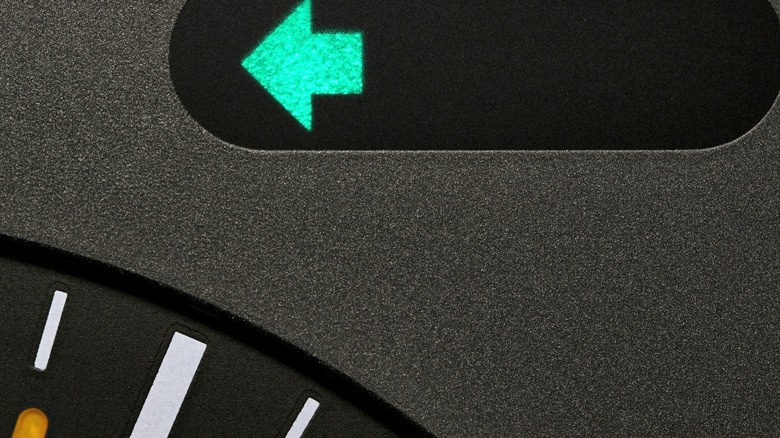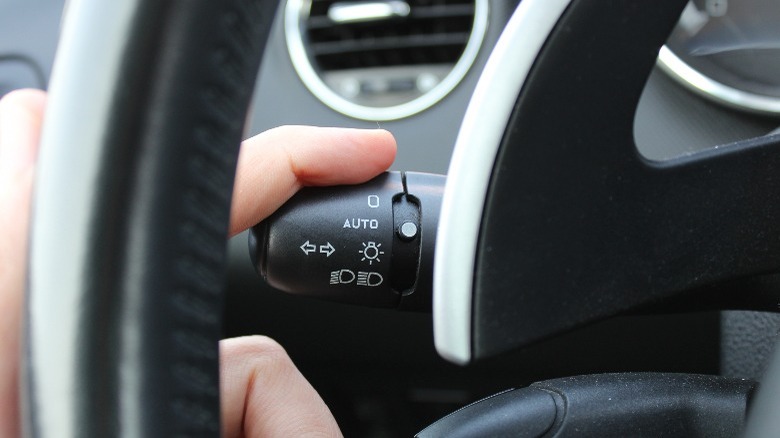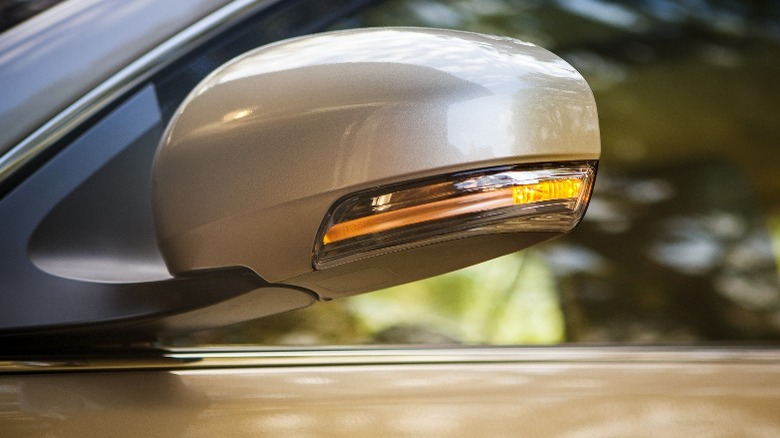Is One Of Your Car's Blinkers Ticking Faster Than The Other? Learn Why
Do you flick on your turn signal and hear one — or even both of your blinkers — tick faster than usual? This isn't some new gimmick with your car. It indicates that there's an electrical issue affecting your turn signal bulbs.
While it's not exactly the most dire problem you might face as a car owner, faulty turn signals can compromise your safety and the safety of other people on the road. Turn signals are there to make your moves predictable, so when you want to change directions, people behind and in front of you can tell and adjust appropriately. Also, driving around without signals is illegal across most states and can land you in some trouble. You can use driving hand gestures if your external lights are unavailable.
Hearing that fast-paced ticking sound should let you know it's time to do something about it. In fact, many modern cars also come with dashboard diagnostics to indicate that you have a dead external bulb. Hearing the ticking sound in conjunction with the dashboard or infotainment indicators can help you track what kind of electrical issues your car might be experiencing.
Luckily, it's one of those car issues that's relatively easy to diagnose and fix. We'll walk you through the most important parts of it so you have a good idea of the system behind it and how to correct it when it occurs.
How do turn signals work?
Imagine your turn signal system as a small, simple network that includes a few key components: a lever (the turn signal switch), a relay (a type of electrically operated switch), light bulbs (the turn signal lights on the outside of your car), flashers, and the car's battery.
When you decide to turn or change lanes, you move the turn signal lever up or down. This is located on one side of your steering wheel column. Moving this lever is like sending a "start" command. It sends an electrical signal to the relay, and when the relay gets the command, it then forwards this command to the turn signal lights on the outside of your car. It connects the circuit, allowing electricity to flow from the car's battery to the lights.
The relay is designed to turn the lights on and off at regular intervals — this is why your turn signals blink. This blinking is important because it catches the attention of other drivers, indicating that you're about to turn or change lanes.
However, flashers in your car are responsible for the blinking of turn signals. They work on a principle that regulates the on-and-off pattern of your lights. Older cars use a thermal mechanism, where a metal strip inside the flasher heats up and cools down to create the blinking effect. Newer cars might use electronic flashers, which control the blinking through electronic circuits.
What causes the blinker to tick faster?
Each bulb in the system adds a certain amount of resistance to the electrical circuit. When a bulb burns out, the circuit loses some of this resistance. The relay, which controls the blinking rate, detects this change in resistance. Since there's less resistance with a bulb out, electricity flows through the circuit more quickly. The relay then speeds up the blinking rate to alert you that something is wrong.
Think of it like this: If you were tapping a drum to a certain beat and suddenly the drumstick became lighter and easier to tap, you might find yourself tapping faster without meaning to. Similarly, with one less bulb in the system adding resistance, the relay "taps" faster, causing the turn signals to blink more rapidly.
While the most common cause of this issue is a dead or burned-out bulb (it's normal for bulbs to die), there are still some other factors that could cause the blinkers to tick rapidly:
- LED bulbs: They draw less power than regular bulbs, so adding aftermarket LEDs could make your blinkers tick faster than normal.
- Wiring issues: If your wiring is damaged, perhaps it's corroded, burned through, loose, or anything to that effect, it could affect the turn signal circuit's performance.
- Bad relay or flasher: When both turn signals are flashing rapidly, and you've ruled out bad bulbs, you might have a bad turn-signal flasher. Cars often use one flasher for both sides and a separate flasher for hazard lights.
How can you stop this rapid blinker issue?
The repairs for rapid blinking could be done on your own, but if you don't feel confident, take your car to an expert. Here are some recommended solutions for those willing to try:
- Diagnose a burned-out bulb: Turn on your turn signal and walk around the vehicle to see if all the turn signal lights are blinking. If one isn't blinking at all, it's likely burned out. If you find a burned-out bulb, replace it. Consult your vehicle's manual for the correct bulb type and instructions on how to replace it. Often, it involves removing the lens cover and replacing the old bulb with a new one.
- Use a bulb with the proper wattage: Ensure that the bulbs installed are the correct wattage for your vehicle. This information can be found in your vehicle's manual or online. If you've installed bulbs of incorrect wattage or switched to LED bulbs, replace them with the correct type recommended by the manufacturer or install appropriate resistors for LEDs. LEDs are blindingly bright anyway; consider removing them to keep the roads safer.
- Inspect and clean the circuit connections: Look for signs of wear, corrosion, and loose connections. Tighten loose connections and clean any corrosion you find with a wire brush or electrical contact cleaner.
- Replace the relay or flasher unit: Consult your vehicle's manual to find the location of the flasher unit or relay. It's often under the dashboard or near the fuse box. If you suspect the flasher unit is faulty, consider replacing it. This is typically a plug-and-play component, easily swapped out.



